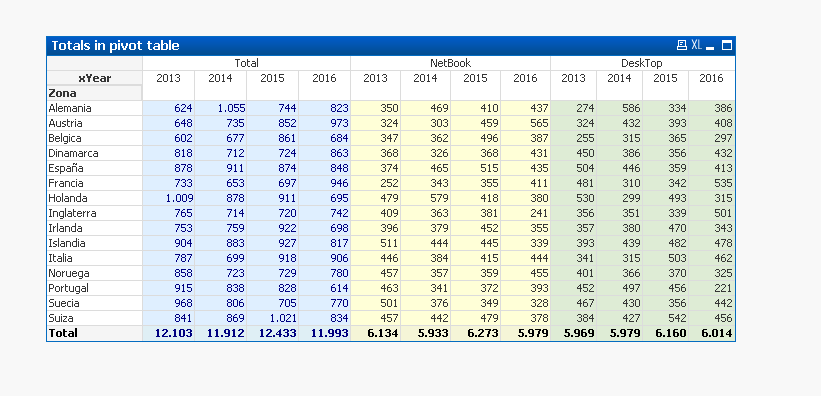Unlock a world of possibilities! Login now and discover the exclusive benefits awaiting you.
- Qlik Community
- :
- All Forums
- :
- QlikView App Dev
- :
- Totals in pivot table
- Subscribe to RSS Feed
- Mark Topic as New
- Mark Topic as Read
- Float this Topic for Current User
- Bookmark
- Subscribe
- Mute
- Printer Friendly Page
- Mark as New
- Bookmark
- Subscribe
- Mute
- Subscribe to RSS Feed
- Permalink
- Report Inappropriate Content
Totals in pivot table
Hi,
I have searched through previous discussions but I haven't been able to find the answer to my particular question. I want to the totals to appear for each year rather than an overall total. I have tried ticking the partial sums I don't get the totals for the year (name, year boundary are all dimensions).
This is what I get
| Boundary | Total | High | High | High | Inlier | Inlier | Inlier | OneDay | OneDay | OneDay | |
| Name | Year | 2010 | 2011 | 2012 | 2010 | 2011 | 2012 | 2010 | 2011 | 2012 | |
| A | 125 | - | 3 | 3 | 42 | 34 | 41 | 1 | - | 1 | |
| B | 43 | 1 | - | 1 | 9 | 12 | 15 | 2 | - | 3 | |
| C | 16 | - | - | - | 4 | 5 | 4 | 1 | 1 | 1 |
This is what I want
| Boundary | Total | Total | Total | High | High | High | Inlier | Inlier | Inlier | OneDay | OneDay | OneDay | |
| Name | Year | 2010 | 2011 | 2012 | 2010 | 2011 | 2012 | 2010 | 2011 | 2012 | 2010 | 2011 | 2012 |
| A | 43 | 37 | 45 | - | 3 | 3 | 42 | 34 | 41 | 1 | - | 1 | |
| B | 12 | 12 | 19 | 1 | - | 1 | 9 | 12 | 15 | 2 | - | 3 | |
| C | 5 | 6 | 5 | - | - | - | 4 | 5 | 4 | 1 | 1 | 1 |
- Tags:
- new_to_qlikview
- « Previous Replies
-
- 1
- 2
- Next Replies »
- Mark as New
- Bookmark
- Subscribe
- Mute
- Subscribe to RSS Feed
- Permalink
- Report Inappropriate Content
Hi
Try useing this expression Sum({$<year={'2010'}>}sales)
Regards
Harsha
- Mark as New
- Bookmark
- Subscribe
- Mute
- Subscribe to RSS Feed
- Permalink
- Report Inappropriate Content
Thanks for your reply. I have only shown a small portion of the data, there are a lot of years in the data and I didn't want to have to add an expression for each year. Do you think that adding an expression is the only way?
Kind regards,
Emer
- Mark as New
- Bookmark
- Subscribe
- Mute
- Subscribe to RSS Feed
- Permalink
- Report Inappropriate Content
can you post some sample data
- Mark as New
- Bookmark
- Subscribe
- Mute
- Subscribe to RSS Feed
- Permalink
- Report Inappropriate Content
Is that you need?

- Mark as New
- Bookmark
- Subscribe
- Mute
- Subscribe to RSS Feed
- Permalink
- Report Inappropriate Content
If you drag the dimensions in the Pivot you can change what is totalled where - so you could group by year and get a total for each year.
Another approach may be to look at creating an association in the data model High, Inlier and OneDay to themselves, and then also to a Total grouping, an inline like this will do this:
SumTotal:
Load
Boundary,
BoundaryTotal
INLINE [
Boundary,BoudnaryTotal
High,High
Inlier,Inlier
OneDay,OneDay
High,Total
Inlier,Total
OneDay,Total
];
You then just use the BoudaryTotal as a dimension rather than Boundary.
I've explained this more fully in this blog post:
http://www.quickintelligence.co.uk/qlikview-accumulate-values/
Steve
- Mark as New
- Bookmark
- Subscribe
- Mute
- Subscribe to RSS Feed
- Permalink
- Report Inappropriate Content
Yes this is what I need
- Mark as New
- Bookmark
- Subscribe
- Mute
- Subscribe to RSS Feed
- Permalink
- Report Inappropriate Content
Thanks Steve, no matter which way I dragged the columns I couldn't get the totals right. I have used the boundary total approach and it works great.
- Mark as New
- Bookmark
- Subscribe
- Mute
- Subscribe to RSS Feed
- Permalink
- Report Inappropriate Content
The file QV with the example
- Mark as New
- Bookmark
- Subscribe
- Mute
- Subscribe to RSS Feed
- Permalink
- Report Inappropriate Content
Thanks Enrique this is very helful
- « Previous Replies
-
- 1
- 2
- Next Replies »